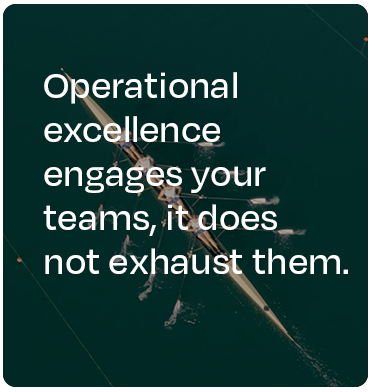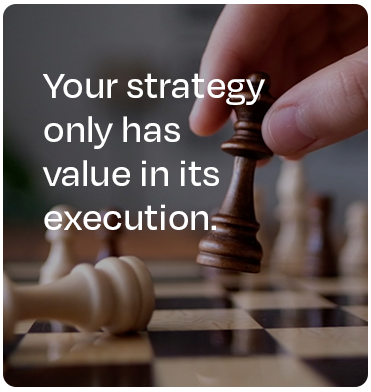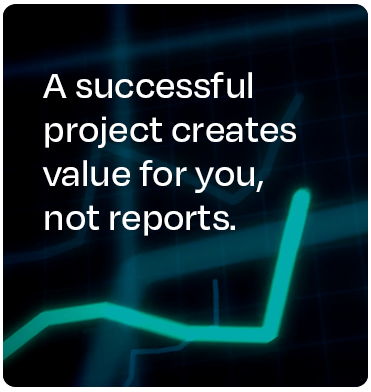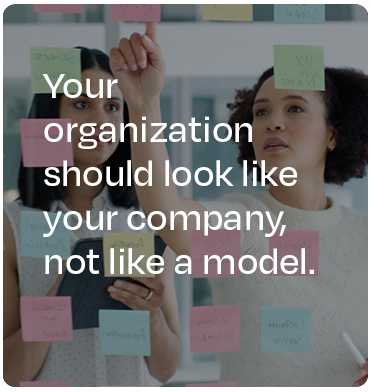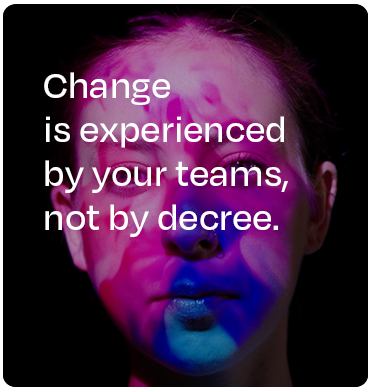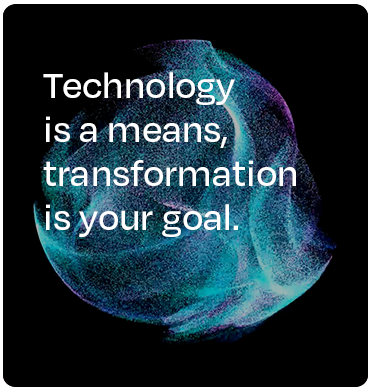Operational excellence is too often seen as a cost-cutting machine—forgetting the human factor.
Why? Because Lean or Six Sigma tools, however powerful, are often imposed top-down. The result: processes optimized on paper, but teams disengaged, complexity returning, and sustainable performance never achieved.
Our difference does not lie in the tools, but in the philosophy. We don’t sell optimized processes—we sell ownership. We don’t impose excellence—we build the engagement that makes it happen. Our method reverses the traditional approach: improvement is driven by field experts—your teams—to guarantee real, adopted, and sustainable performance.
Proof through impact: our method in action

The challenge:
A production site had implemented a very strict Lean optimization program. The result: demotivated teams who felt “robotized” and an increase in turnover.
Our action (regenerative approach):
We replaced multiple anxiety-inducing KPIs with 5 key indicators co-designed with operators. More importantly, we gave them autonomy and the tools to solve problems in their own scope.
The result:
In 6 months, teams themselves reduced non-conformities by 40% in their area. Absenteeism was simultaneously cut in half—proving that engagement and performance are linked.
Methodology
Our 4-phase method: Excellence by teams, for performance
Phase 1 : Observe & align
Understand the reality of work before trying to optimize it.
We begin with a shared diagnosis that reveals real problems and aligns everyone around a common “why.”
• Value Stream Mapping (VSM) to visualize the journey from customer demand to satisfaction.
• Identification of waste (Muda) frustrating teams and harming customers (waiting times, unnecessary tasks, complexity, etc.)
• Alignment on priorities: Defining together the few performance indicators that truly matter for both customers AND employees
→ Deliverable: Shared diagnosis of flows and pain points, and a common vision of improvement objectives.
Phase 2 : Simplify & co-construct
Solve problems with those who live them every day.
We don’t provide “off-the-shelf” solutions. We facilitate problem-solving by field experts—your teams.
• Problem-solving workshops (A3-type) equipping teams to tackle root causes of pain points themselves
• Co-construction of simplified processes: teams redesign how they work, we provide method and critical perspective
• Formalization of new standards defined by the teams to ensure clarity, consistency, and relevance
→ Deliverable: Simplified target processes and work standards co-designed and validated by teams.
Phase 3 : Experiment & improve
Test, measure, and learn to spark continuous improvement.
We pilot new practices to prove effectiveness and empower teams in improvement.
• Short experimentation cycles (PDCA) on pilot scopes to test new standards in real conditions
• Measuring impact on performance (lead times, quality) AND team satisfaction.
• Celebrating learnings and adjusting standards based on field feedback
→ Deliverable: Proof of the effectiveness of new standards and teams capable of running their own improvement cycles.
Phase 4 : Standardize & sustain
Anchor best practices so improvement becomes a culture.
We ensure new ways of working become the norm and that the organization has the means to keep progressing.
• Formalizing validated standards as living, accessible references
• Establishing performance rituals (gemba walks, daily stand-ups) led by managers
• Coaching managers to shift from “controllers” to “facilitators” of continuous improvement
→ Deliverable: A sustainable performance management system, driven by teams and their managers.
What sets us apart
Ce qui nous distingue
| Classic Operational Excellence | Engaged operational excellence™ |
|---|---|
| Processes imposed by experts | Standards co-designed by teams |
| Managers as “controllers” | Managers as “facilitators” |
| Rigid processes | Framed autonomy |
| Disengagement & resistance | Ownership & accountability |
| One-off optimization | Culture of continuous improvement |
| Endured performance | Chosen & sustainable performance |
